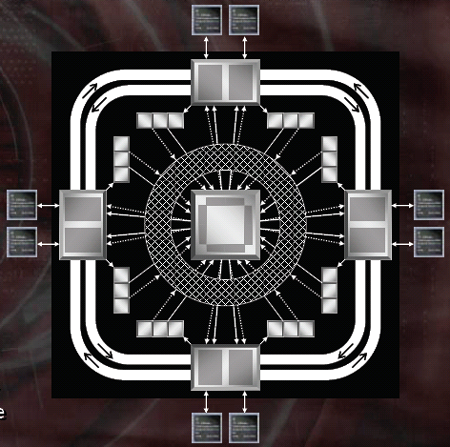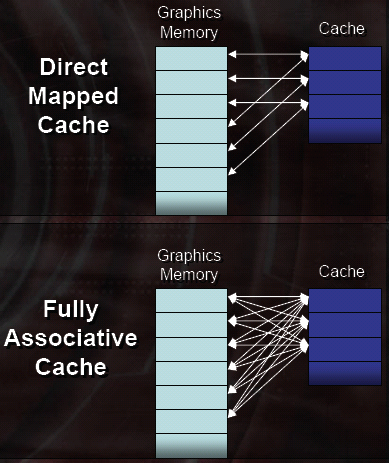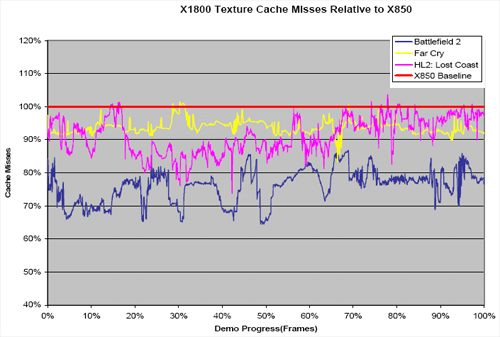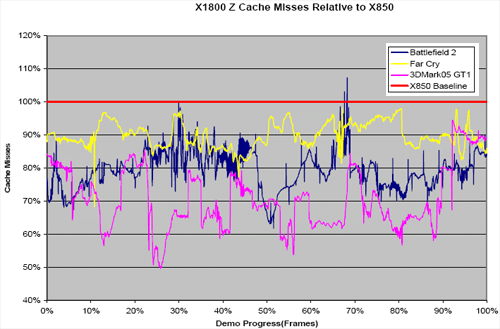ATI's Late Response to G70 - Radeon X1800, X1600 and X1300
by Derek Wilson on October 5, 2005 11:05 AM EST- Posted in
- GPUs
Memory Architecture
One of the newest features of the X1000 series is something ATI calls a "ring bus" memory architecture. The general idea behind the design is to improve memory bandwidth effectiveness while reducing cache misses, resulting in overall better memory performance. The architecture already supports GDDR4, but current boards have to settle for the fastest GDDR3 available until memory makers ship GDDR4 parts.
For quite some time, the high end in graphics memory architecture has been a straight forward 256-bit bus divided into four 64-bit channels on the GPU. The biggest issues with scaling up this type of architecture are routing, packaging and clock speed. Routing 256 wires from the GPU to RAM is quite complex. Cards with large buses require printed circuit boards (PCBs) with more layers than a board with a smaller bus in order to compensate for the complexity.
In order to support such a bus, the GPU has to have 256 physical external connections. Adding more and more external connections to a single piece of silicon can also contribute to complexities in increasing clock speed or managing clock speeds between the memory devices and the GPU. In the push for ever improving performance, increasing clock speed and memory bandwidth are constantly evaluated for cost and benefit.
Rather than pushing up the bit width of the bus to improve performance, ATI has taken another approach: improving the management and internal routing of data. Rather than 4 64-bit memory interfaces hooked into a large on die cache, the GPU hass 4 "ring stops" that connect to each other, graphics memory, and multiple caches and clients within the GPU. Each "ring stop" has 2 32-bit connections to 2 memory modules and 2 outgoing 256-bit connections to 2 other ring stops. ATI calls this a 512-bit Ring Bus (because there are 2 256-bit rings going around the ring stops).

Routing incoming memory through a 512-bit internal bus helps ATI to get data where it needs to go quickly. Each of the ring stops connects to a different set of caches. There are 30+ independent clients that require memory access within an X1000 series GPU. When one of these clients needs data not in a cache, the memory controller forwards the request to the ring stop attached to the physical memory with the data required. That ring stop then forwards the data around the ring to the ring stop (and cache) nearest the requesting client.

The primary function of memory management shifts to keeping the caches full with relevant information. Rather than having the memory controller on the GPU aggregate requests and control bandwidth, the memory controllers and ring bus work to keep data closer to the hardware that needs it most and can deal with each 32-bit channel independently. This essentially trades bandwidth efficiency for improved latency between memory and internal clients that require data quickly. With writes cached and going though the crossbar switch and the ring bus keeping memory moving to the cache nearest the clients that need data, ATI is able to tweak their caches to fit the new design as well.
On previous hardware, caches were direct mapped or set associative. This means that every address in memory maps to a specific cache line (or set in set associative). With larger caches, direct mapped and set associative designs work well (like L3 and L2 caches on a CPU). If a smaller cache is direct mapped, it is very easy for useful data to get kicked out too early by other data. Conversely, a large fully associative cache is inefficient as the entire cache must be searched for a hit rather than one line (direct mapped) or one block (set associative).

It makes sense that ATI would move to a fully associative cache in this situation. If they had large cache that serviced the entire range of clients and memory, a direct mapped (or more likely some n-way set associative cache) could make sense. With this new ring bus, if ATI split caches into multiple smaller blocks that service specific clients (as it appears they may have done), fully associative caches do make sense. Data from memory will be able to fill up the cache no matter where it's from, and searching smaller caches for hits shouldn't cut into latency too much. In fact, with a couple fully associative caches heavily populated with relevant data, overall latency should be improved. ATI showed us some Z and texture cache miss rates releative to X850. This data indicates anywhere from 5% to 30% improvement in cache miss rates among a few popular games from their new system.
The following cache miss scaling graphs are not data collected by us, but reported by ATI. We do not currently have a way to reproduce data like this. While assuring that the test is impartial and accurate is not possible in this situation (so take it with a grain of salt), the results are interesting enough for us to share them.


In the end, if common data patterns are known, cache design is fairly simple. It is easy to simulate cache hit/miss data based on application traces. A fully associative cache has its down sides (latency and complexity), so simply implementing them everywhere is not an option. Rather than accepting that fully associative caches are simply "better", it is much safer to say that a fully associative cache fits the design and makes better use of available resources on X1000 series hardware when managing data access patterns common in 3d applications.
Generally, bandwidth is more important than latency with graphics hardware as parallelism lends itself to effective bandwidth utilization and latency hiding. At the same time, as the use of flow control and branching increase, latency could potentially become more important than it is now.
The final new aspect of ATI's memory architecture is programmable bus arbitration. ATI is able to update and adapt the way the driver/hardware prioritizes memory access. The scheme is designed to weight memory requests based on a combination of latency and priority. The priority based scheme allows the system to determine and execute the most critical and important memory requests first while allowing data less sensitive to latency to wait its turn. The impression we have is that requests are required to complete within a certain number of cycles in order to prevent the starvation of any given thread, so the longer a request waits the higher its priority becomes.
ATI's ring bus architecture is quite interesting in and of itself, but there are some added benefits that go along with such a design. Altering the memory interface to connect with each memory device independently (rather than in 4 64-bit wide busses) gives ATI some flexibility. Individually routing lines in 32-bit groups helps to make routing connections more manageable. It's possible to increase stability (or potential clock speed) with simpler connections. We've already mentioned that ATI is ready to support GDDR4 out of the box, but there is also quite a bit of potential for hosting very high clock speed memory with this architecture. This is of limited use to customers who buy the product now, but it does give ATI the potential to come out with new parts as better and faster memory becomes available. The possibility of upgrading the 2 32-bit connections to something else is certainly there, and we hope to see something much faster in the future.
Unfortunately, we really don't have any reference point or testable data to directly determine the quality of this new design. Benchmarks will show how the platform as a whole performs, but whether the improvements come from the pixel pipelines, vertex pipelines, the memory controller, ring architecture, etc. is difficult to say.
One of the newest features of the X1000 series is something ATI calls a "ring bus" memory architecture. The general idea behind the design is to improve memory bandwidth effectiveness while reducing cache misses, resulting in overall better memory performance. The architecture already supports GDDR4, but current boards have to settle for the fastest GDDR3 available until memory makers ship GDDR4 parts.
For quite some time, the high end in graphics memory architecture has been a straight forward 256-bit bus divided into four 64-bit channels on the GPU. The biggest issues with scaling up this type of architecture are routing, packaging and clock speed. Routing 256 wires from the GPU to RAM is quite complex. Cards with large buses require printed circuit boards (PCBs) with more layers than a board with a smaller bus in order to compensate for the complexity.
In order to support such a bus, the GPU has to have 256 physical external connections. Adding more and more external connections to a single piece of silicon can also contribute to complexities in increasing clock speed or managing clock speeds between the memory devices and the GPU. In the push for ever improving performance, increasing clock speed and memory bandwidth are constantly evaluated for cost and benefit.
Rather than pushing up the bit width of the bus to improve performance, ATI has taken another approach: improving the management and internal routing of data. Rather than 4 64-bit memory interfaces hooked into a large on die cache, the GPU hass 4 "ring stops" that connect to each other, graphics memory, and multiple caches and clients within the GPU. Each "ring stop" has 2 32-bit connections to 2 memory modules and 2 outgoing 256-bit connections to 2 other ring stops. ATI calls this a 512-bit Ring Bus (because there are 2 256-bit rings going around the ring stops).

Routing incoming memory through a 512-bit internal bus helps ATI to get data where it needs to go quickly. Each of the ring stops connects to a different set of caches. There are 30+ independent clients that require memory access within an X1000 series GPU. When one of these clients needs data not in a cache, the memory controller forwards the request to the ring stop attached to the physical memory with the data required. That ring stop then forwards the data around the ring to the ring stop (and cache) nearest the requesting client.

The primary function of memory management shifts to keeping the caches full with relevant information. Rather than having the memory controller on the GPU aggregate requests and control bandwidth, the memory controllers and ring bus work to keep data closer to the hardware that needs it most and can deal with each 32-bit channel independently. This essentially trades bandwidth efficiency for improved latency between memory and internal clients that require data quickly. With writes cached and going though the crossbar switch and the ring bus keeping memory moving to the cache nearest the clients that need data, ATI is able to tweak their caches to fit the new design as well.
On previous hardware, caches were direct mapped or set associative. This means that every address in memory maps to a specific cache line (or set in set associative). With larger caches, direct mapped and set associative designs work well (like L3 and L2 caches on a CPU). If a smaller cache is direct mapped, it is very easy for useful data to get kicked out too early by other data. Conversely, a large fully associative cache is inefficient as the entire cache must be searched for a hit rather than one line (direct mapped) or one block (set associative).

It makes sense that ATI would move to a fully associative cache in this situation. If they had large cache that serviced the entire range of clients and memory, a direct mapped (or more likely some n-way set associative cache) could make sense. With this new ring bus, if ATI split caches into multiple smaller blocks that service specific clients (as it appears they may have done), fully associative caches do make sense. Data from memory will be able to fill up the cache no matter where it's from, and searching smaller caches for hits shouldn't cut into latency too much. In fact, with a couple fully associative caches heavily populated with relevant data, overall latency should be improved. ATI showed us some Z and texture cache miss rates releative to X850. This data indicates anywhere from 5% to 30% improvement in cache miss rates among a few popular games from their new system.
The following cache miss scaling graphs are not data collected by us, but reported by ATI. We do not currently have a way to reproduce data like this. While assuring that the test is impartial and accurate is not possible in this situation (so take it with a grain of salt), the results are interesting enough for us to share them.


In the end, if common data patterns are known, cache design is fairly simple. It is easy to simulate cache hit/miss data based on application traces. A fully associative cache has its down sides (latency and complexity), so simply implementing them everywhere is not an option. Rather than accepting that fully associative caches are simply "better", it is much safer to say that a fully associative cache fits the design and makes better use of available resources on X1000 series hardware when managing data access patterns common in 3d applications.
Generally, bandwidth is more important than latency with graphics hardware as parallelism lends itself to effective bandwidth utilization and latency hiding. At the same time, as the use of flow control and branching increase, latency could potentially become more important than it is now.
The final new aspect of ATI's memory architecture is programmable bus arbitration. ATI is able to update and adapt the way the driver/hardware prioritizes memory access. The scheme is designed to weight memory requests based on a combination of latency and priority. The priority based scheme allows the system to determine and execute the most critical and important memory requests first while allowing data less sensitive to latency to wait its turn. The impression we have is that requests are required to complete within a certain number of cycles in order to prevent the starvation of any given thread, so the longer a request waits the higher its priority becomes.
ATI's ring bus architecture is quite interesting in and of itself, but there are some added benefits that go along with such a design. Altering the memory interface to connect with each memory device independently (rather than in 4 64-bit wide busses) gives ATI some flexibility. Individually routing lines in 32-bit groups helps to make routing connections more manageable. It's possible to increase stability (or potential clock speed) with simpler connections. We've already mentioned that ATI is ready to support GDDR4 out of the box, but there is also quite a bit of potential for hosting very high clock speed memory with this architecture. This is of limited use to customers who buy the product now, but it does give ATI the potential to come out with new parts as better and faster memory becomes available. The possibility of upgrading the 2 32-bit connections to something else is certainly there, and we hope to see something much faster in the future.
Unfortunately, we really don't have any reference point or testable data to directly determine the quality of this new design. Benchmarks will show how the platform as a whole performs, but whether the improvements come from the pixel pipelines, vertex pipelines, the memory controller, ring architecture, etc. is difficult to say.










103 Comments
View All Comments
DerekWilson - Friday, October 7, 2005 - link
Hello,Rather than update this article with the tables as we had planned, we decided to go all out and collect enough data to build something really interesting.
http://anandtech.com/video/showdoc.aspx?i=2556">http://anandtech.com/video/showdoc.aspx?i=2556
Our extended performance analysis should be enough to better show the strengths and weaknesses of the X1x00 hardware in all the games we tested in this article plus Battlefield 2.
I would like to apologize for not getting more data together in time for this article, but I hope the extended performance tests will help make up for what was lacking here.
And we've got more to come as well -- we will be doing an in-depth follow up on new feature performance and quality as well.
Thanks,
Derek Wilson
MiLLeRBoY - Thursday, October 6, 2005 - link
If NVIDIA puts out a 7800XT with a bigger cooler, which makes the video card dual slots, instead of just one slot. This would allow them to increase the speeds of the RAM and GPU. And if they increase it to 512MB ram, they will knock ATI’s X1800XT off the map completely.MiLLeRBoY - Thursday, October 6, 2005 - link
oops, 7800 GTX, I mean, lol.stephenbrooks - Thursday, October 6, 2005 - link
Maybe a solution for all the complaints about review-quality would be for AnandTech to put its reviews through "beta"? :pwaldo - Thursday, October 6, 2005 - link
So, I am back, and as always confused!Where are we now? We have at THG the same card beating teh 7800GTX hands down in several instances....and here at Anand, we have the ATI version barely holding its head above water.....talk about weird inconsistencies....someone is tweaking the numbers or the machines....one or the other.
Some of me would like to give the nod to THG because they have a history of doing more accurate more complete video card reviews, but this is just crazy....can someone at Anand please explain, cause well, I know THG won't.
tomoyo - Thursday, October 6, 2005 - link
In terms of pricing, I think Nvidia has Ati beaten in every category of card currently.I think the competition that ATI is marketing each card against is as follows(even if the prices have a huge disparity currently):
X1800XT vs 7800GTX
X1800XL vs 7800GT
X1600XT vs 6800/6600GT
X1600Pro vs 6600GT/6600
x1300Pro vs 6600
x1300 vs 6200
From what I've seen of the reviews from anandtech, techreport, and a couple other sources it looks like the X1800XT/XL are pretty competitive with their competition, however I really dislike the extra power consumption and of course the cost of the card. I think the 7800 is a far better solution in terms of most categories except a few minor features like having HDR/AA at the same time. It looks like it's possible the X1800 might have some gains in future games because of the better memory controller and threading pixel shader, but it seems rather useless for now.
The x1600 looks like the biggest disappointment by far. It's nowhere near the league of the 6800 cards and barely outperforms the 6600gt, which has a huge price advantage. The x800gto2 looks like a far better card than the x1600 here. Personally I'm hoping nvidia does what's expected and puts out a 90nm 7600 that has a decent performance gain over the 6600gt. That might be one of the best silent computing cards around when it comes out. (I'm hoping to replace my 6600 with this now that the x1600 is no upgrade for me)
The x1300 actually looks like the most promising chip to me. It's obviously not worthwhile for gamers, but I think it might turn out to be a pretty good drop-in card for non-gaming systems. It's all dependent on whether it can hit the price point for the under $100(or is that under $70) market well. It certainly looks like it'll outperform the 6200 and x300 and be the new standard for entry level systems... until nvidia's next entry card. Not to mention most of the x1x00 generation features are still included with the x1300 card.
AtaStrumf - Thursday, October 6, 2005 - link
Totaly disappointed in both ATi and AT.As for X1300 don't forget this is the best version out of X1300 family and I can't help but remember the FX 5200 Ultra, which looked great but was never really available, because they could not produce it at low enough price point. I think same will happen here.
bob661 - Thursday, October 6, 2005 - link
Very nice summary.andyc - Wednesday, October 5, 2005 - link
So what card is the "real" competitor to the 7800GT, becuase frankly, I'm totally confused which card ATI is trying to use to compete against it.Pete - Wednesday, October 5, 2005 - link
X1800XL.